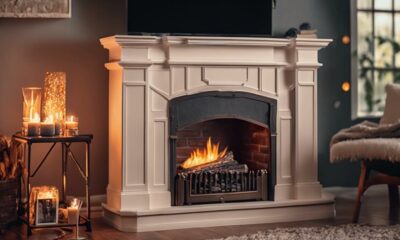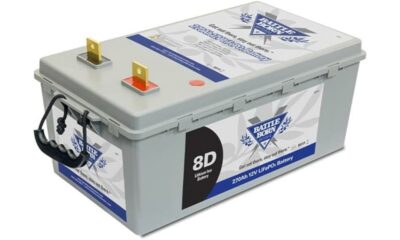Home Decor
Step-by-Step Guide for Painting a Mirror
Achieve a stunning work of art by following these expert steps to transform your plain mirror into a masterpiece that will leave everyone mesmerized.
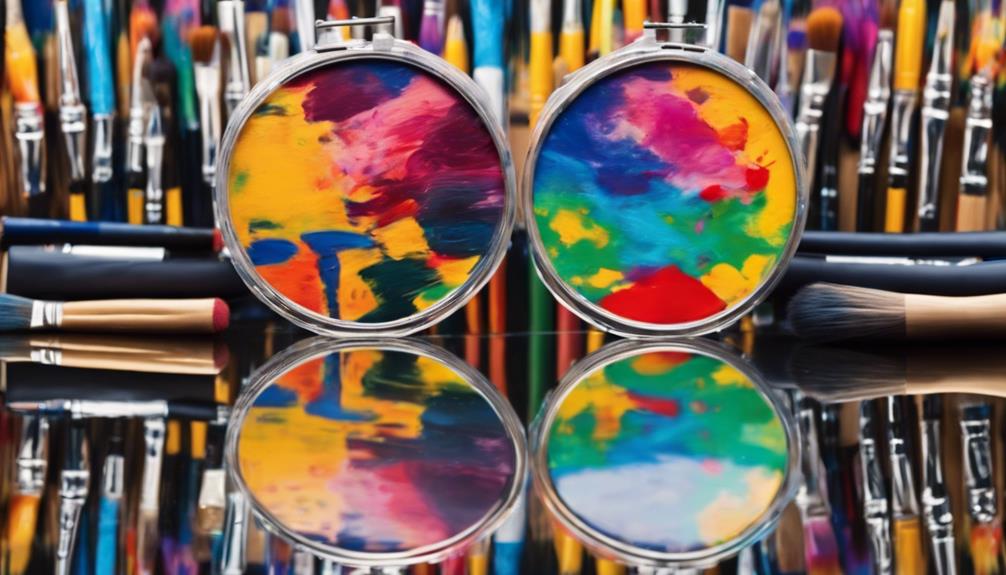
You're about to transform a plain mirror into a stunning work of art. Start by preparing the mirror surface with a thorough cleaning, sketching your design, applying white gesso, and letting it dry for 24 hours. Choose the right paint for your project, whether it's acrylic, enamel, or Deco Art glass paint, and apply a base coat. From there, add your design and patterns, letting each layer dry completely before adding the next. Finally, seal your masterpiece with a clear coat and display it proudly. As you continue, you'll uncover the precise techniques and expert tips to achieve a truly professional finish.
Key Takeaways
• Prepare the mirror surface by cleaning it with a dampened microfiber cloth and applying a layer of white gesso as a base.
• Choose the right paint for your project, considering options like acrylic, enamel, or Deco Art glass paint for optimal results.
• Apply a white acrylic base coat to ensure vibrant colors and a strong bond with the paint, letting it dry for at least 24 hours.
• Use stencils, templates, and varying brush sizes to add design and patterns, experimenting with different techniques like stippling and blending.
• Seal your artwork with a clear coat, following the manufacturer's instructions for drying time, to protect and enhance the colors.
Preparing the Mirror Surface
Before you begin painting, prepare the mirror surface by thoroughly cleaning it with a dampened microfiber cloth to remove any dirt or grime that may affect the paint adhesion. This step is vital, as a clean mirror is essential for the paint to adhere properly.
Once your mirror is clean, you can start planning out your design. Take a water-soluble pencil and sketch out your design directly onto the mirror surface. This will give you a clear idea of what your final product will look like.
Next, apply a layer of white gesso to the areas of the mirror that will be painted. This will establish a suitable base for your paint to adhere to. Make sure to let the gesso dry for at least 24 hours to guarantee it fully sets and provides a smooth surface for painting.
Choosing the Right Paint
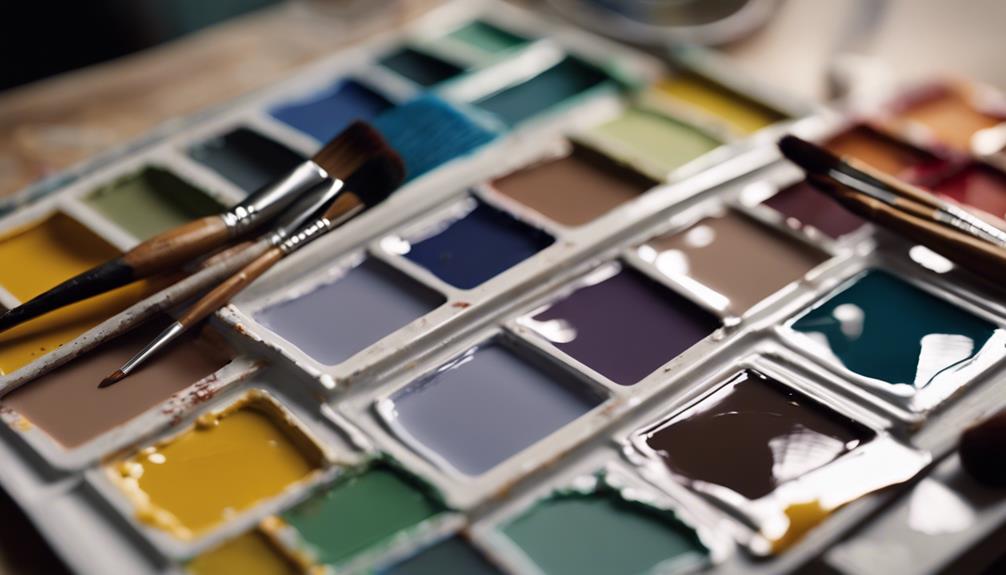
When selecting the right paint for your mirror, you'll need to take into account the type of paint, the colors you want to use, and the finish and sheen you're aiming for.
You'll need to choose between enamel, acrylic, or specialized glass paint, each with its own benefits and drawbacks. As you evaluate your options, think about the overall aesthetic you want to achieve and how the paint's finish will impact the final result.
Paint Type Options
As you prepare to paint your mirror, selecting the right paint type is essential, and you'll want to take into account the unique characteristics of acrylic, enamel, and Deco Art glass paint to achieve your desired design.
Acrylic paint, a popular choice for mirror painting, is quick-drying and versatile, making it ideal for intricate designs.
Enamel paint, on the other hand, offers durability and a softer finish, making it perfect for long-lasting mirror designs.
If you're looking for a paint specifically formulated for glass surfaces like mirrors, Deco Art glass paint is the way to go.
When choosing between acrylic and enamel paints, consider the desired finish and longevity of your mirror design.
Additionally, using a white acrylic base coat before painting can enhance the vibrancy and opacity of your design.
Paint Color Selection
Now that you've selected the right paint type, it's time to choose a color palette that complements your mirror's design and the surrounding décor.
When it comes to painting a mirror, the color selection is essential to achieve the desired look. You really want to contemplate the overall aesthetic you're going for – modern, vintage, or eclectic.
If you're looking for a clean and crisp look, white acrylic paint can be used as a base coat before adding additional colors. This will provide a solid foundation for your design.
For a softer, subtler finish, enamel paints might be the way to go. Remember, the type of paint you chose earlier will influence your color selection. Acrylic paints, like Deco Art, offer vibrant colors and durability, while enamel paints provide a softer, more subtle finish.
Take your time, and really ponder about the colors that will make your mirror stand out. With the right paint color, your mirror will be transformed into a stunning piece of art that adds personality to any room.
Finish and Sheen
Choosing the right finish and sheen for your mirror involves balancing durability, aesthetics, and personal preference. You'll need to take into account the overall look and feel you're aiming for, as well as how much wear and tear the mirror will endure.
Here's a breakdown of popular paint finishes for mirrors:
| Finish | Durability | Aesthetics |
|---|---|---|
| Acrylic Paint | Moderate | Glossy, reflective |
| Enamel Paint | High | Subtle, elegant |
| Matte Spray Paint | Low | Non-reflective, understated |
| Metallic Paint | Moderate | Unique, eye-catching |
Acrylic paint provides a glossy finish, while enamel paint offers a more durable and subtle sheen. If you desire a non-reflective finish, matte spray paint is the way to go. And if you're feeling bold, metallic paint can add a touch of glamour to your mirror. Remember to select a finish that fits your style and the mirror's intended use.
Applying the Base Coat
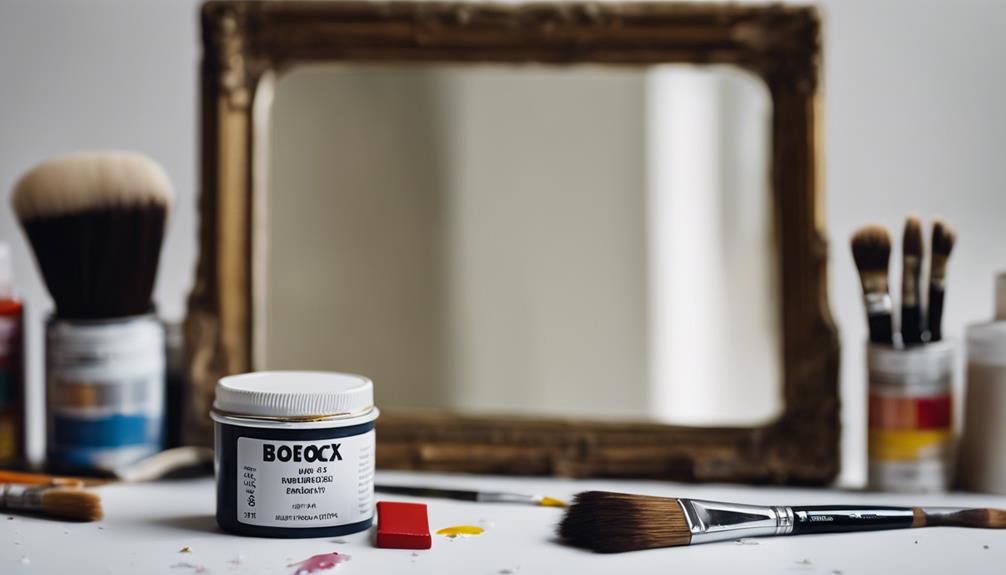
You'll start by applying an essential layer of white gesso as your base coat, which serves as a primer to guarantee your paint adheres smoothly to the mirror's surface. This base coat is pivotal, as it prevents the paint from peeling off the mirror surface.
By using white gesso, you're ensuring that your paint will adhere better, creating a strong bond that will last. In addition to its adhesive properties, the white gesso also creates a smooth surface for the paint to adhere to, resulting in a more even and long-lasting finish.
Before moving on to the next step, make sure to let the white gesso dry for at least 24 hours. If you're looking for an alternative, you can also use a white acrylic base coat, which will enhance the vibrancy of the colors you'll be using later on.
Adding Design and Patterns
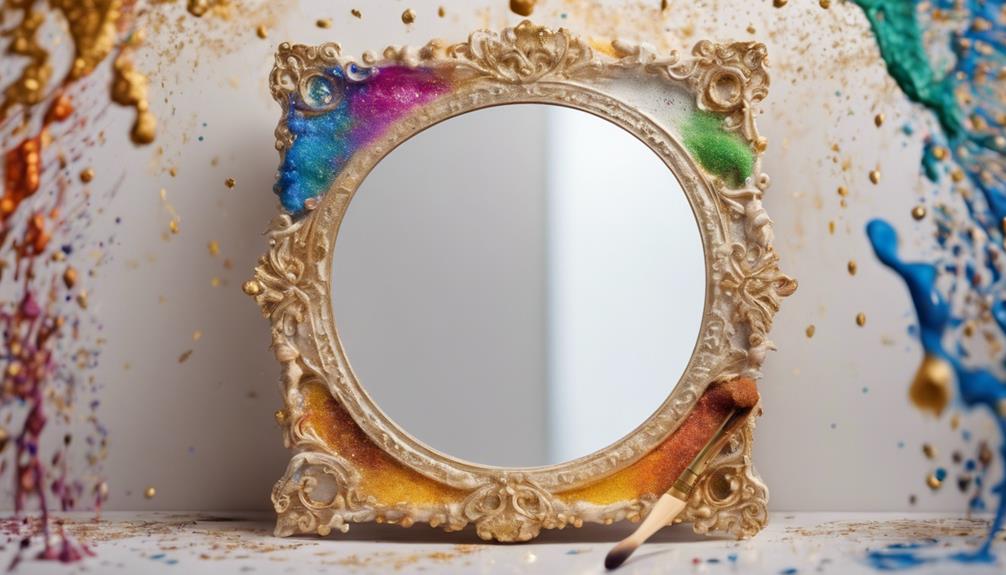
Sketch the design and patterns you want to feature on your mirror using water-soluble pencils, allowing you to easily erase and refine your composition. This step is vital in achieving the intricate designs you envision on your mirror surface.
To add more depth and visual interest, experiment with different brush sizes to create varying line thicknesses and details in your design. Consider using stencils or templates for precise and intricate patterns on the mirror.
Don't be afraid to incorporate a variety of colors and shades to enhance the visual interest and depth of your design. Techniques like stippling, blending, and layering can add texture and dimension to your painted patterns on the mirror.
Allowing the Paint to Dry
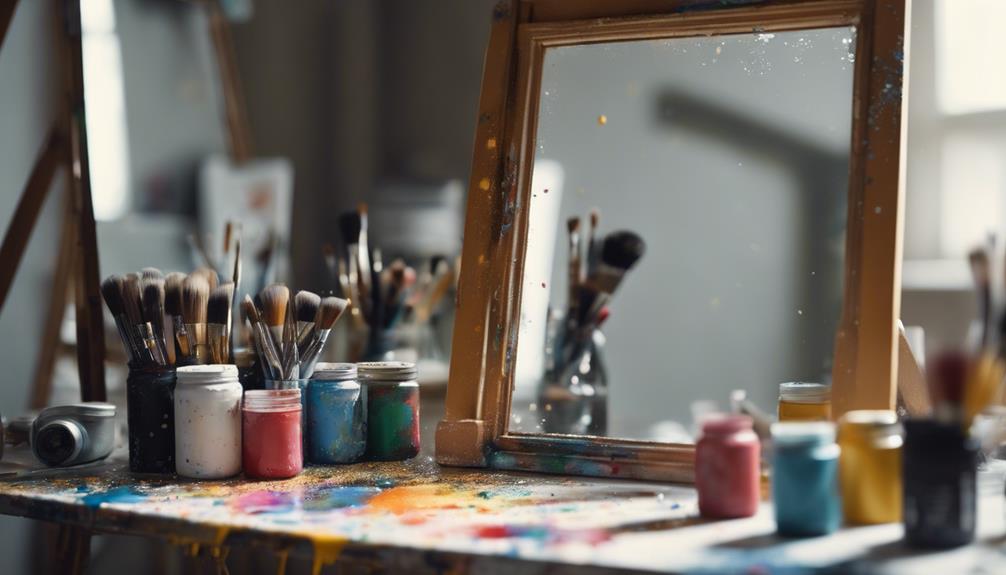
With your design carefully crafted, it's time to let your paint dry completely before adding additional coats or sealants. Proper drying time is important for a successful mirror painting project, so be patient and don't rush the process.
Acrylic paint typically dries within 20-30 minutes between coats, but enamel paint may take longer, up to several hours. If you've applied thicker layers of paint, expect a longer drying time. Make sure each layer is fully dry before applying the next coat to avoid smudging or blending colors.
Sealing the Painted Mirror
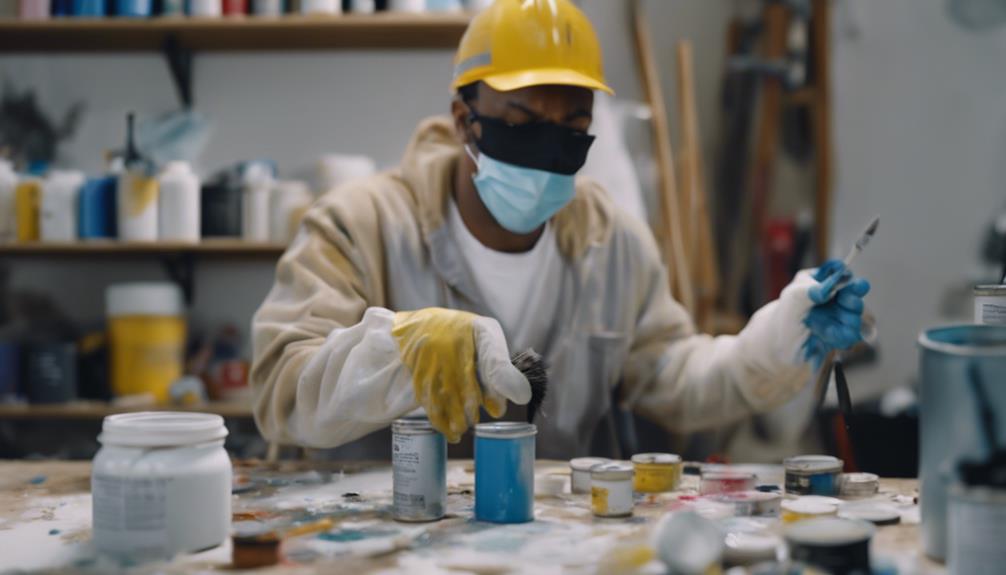
As you move forward with sealing your painted mirror, it's crucial to focus on a few critical areas to guarantee a professional-looking finish.
You'll need to pay special attention to sealing the edges, where the paint can be more prone to chipping, and take steps to prevent these issues from arising.
Sealing the Edges
Seal the edges of your painted mirror with a clear acrylic sealant to safeguard the paint and guarantee a long-lasting finish. This critical step ensures that your hard work doesn't go to waste, and your mirror remains looking great for years to come.
When applying the sealant, make sure to cover all the painted areas, including the edges, with a thin, even layer. This will prevent chipping and peeling, keeping your mirror looking fresh and vibrant.
Remember to allow the sealant to dry completely before hanging or using your mirror. A sealed mirror will have a longer-lasting and protected paint finish, giving you peace of mind and a beautiful piece of decor for your home.
Preventing Chipping Issues
You'll safeguard your painted mirror's finish by applying a clear varnish or sealant, which prevents chipping and protects the paint from damage.
To do this effectively, make sure the paint is completely dry before applying another coat or the sealant to prevent smudging or streaking.
When applying the clear varnish, use a soft cloth or paper towel to gently wipe it onto the mirror, ensuring to wipe off any excess paint for a smooth finish.
Apply the sealant in thin, even layers to maintain the integrity of the painted design on the mirror. This will prevent the paint from chipping and ensure a professional-looking finish.
Allow the sealant to dry according to the manufacturer's instructions before handling or hanging the painted mirror.
Applying Clear Coat
With your painted mirror design complete, it's time to shield your artwork with a clear coat, ensuring the vibrant colors and intricate details remain intact for years to come.
Applying a clear coat or sealant is an important step in protecting your artwork from damage and ensuring its longevity.
Here are some essential tips to keep in mind when applying a clear coat:
- Choose the right sealant: Select a sealant that's compatible with your paint type, whether it's acrylic, oil-based, or spray paints.
- Apply evenly: Use a soft cloth or paper towel to apply the sealant, preventing streaks or smudges on the painted surface.
- Enhance the finish: Sealants can enhance the colors of the paint and provide a glossy or matte finish, depending on your preference.
Removing Masking and Cleanup
As you carefully remove the painter's tape from the edges of the mirror frame, clean lines are revealed, marking the beginning of the cleanup process. You'll be amazed at how crisp and clean the paint job looks. Next, use a razor blade or craft knife to gently scrape off any excess paint on the mirror surface. Be careful not to scratch the glass.
| Task | Tool | Purpose |
|---|---|---|
| Remove tape | Fingers | Reveal clean lines |
| Scrape excess paint | Razor blade or craft knife | Remove paint from mirror surface |
| Clean mirror | Glass cleaner and microfiber cloth | Remove residue |
| Inspect and touch-up | Eyes and paint | Ensure a flawless finish |
Now, wipe down the mirror with a clean microfiber cloth and glass cleaner to remove any remaining residue. Check the painted mirror frame for any touch-ups needed and make corrections as necessary. Finally, dispose of any used materials properly and make sure the painting area is clean and organized.
Displaying Your Masterpiece
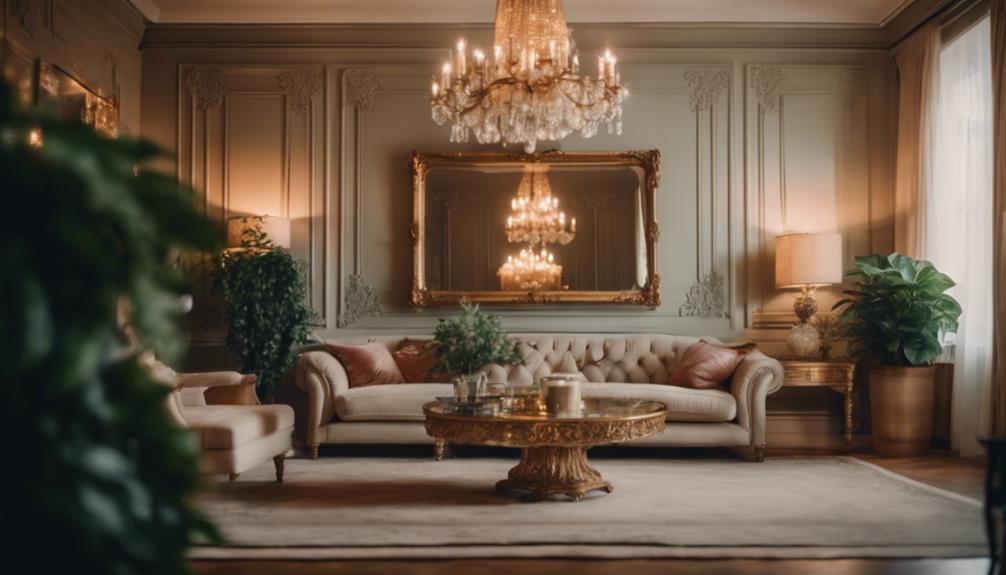
Now that your painted mirror is complete, it's time to showcase it in a location that highlights its beauty and craftsmanship. You've invested a small amount of time and effort into Paint a Mirror, so it's crucial to display it proudly.
Here are a few tips to keep in mind when displaying your masterpiece:
- Well-lit area: Hang your mirror in a well-lit area to showcase the colors and details. This will make your Spray painting a mirror project stand out even more.
- Complementary decor: Use complementary decor around the mirror to enhance its visual impact in the room. This will create a cohesive look and make your mirror a focal point.
- Ideal viewing: Position the mirror at eye level for ideal viewing and to make it a focal point in the space. This will ensure your mirror is quite the center of attention.
Frequently Asked Questions
What Kind of Paint Will Stick to a Mirror?
When it comes to painting on mirrors, you'll need a specialized paint that can adhere well to the glass surface. You'll find that acrylic paint formulated for glass, such as Deco Art, is a great option.
Enamel craft paints also work well, providing a durable and subtle finish. Whichever you choose, make sure to prime the mirror with white gesso first to guarantee the paint sticks.
How to Prep a Mirror for Painting?
As you prepare to paint your mirror, did you know that a staggering 75% of DIY projects fail due to inadequate surface preparation?
To avoid this, you'll want to start by cleaning your mirror with a damp microfiber cloth to remove dirt and grime.
Then, use a water-soluble pencil to sketch your design onto the mirror's surface.
This vital step guarantees a smooth painting process and prevents costly mistakes down the line.
How to Seal Acrylic Paint on a Mirror?
When you're sealing acrylic paint on a mirror, you'll want to use a clear acrylic sealer or varnish to protect the painted surface.
Apply the sealant in thin, even coats to prevent drips or streaks, allowing each coat to dry completely before adding more layers.
Use a soft brush or sponge to apply the sealant smoothly, and consider a UV-resistant sealant to prevent fading in direct sunlight.
What Do You Cover a Mirror With When Painting?
As you stand before the mirror, paintbrush in hand, you ponder how to cover it with something to prevent unwanted splatters.
Picture a pristine mirror, untouched by paint droplets. To achieve this, you'll need to cover the mirror's glass surface.
You can use painter's tape to create a barrier, carefully applying it along the edges to guarantee a precise fit. Alternatively, consider using paper or plastic sheeting for complete coverage.
Conclusion
As you step back to admire your handiwork, the transformed mirror seems to radiate a new energy, its vibrant colors and intricate patterns drawing you in like a work of art.
The paint's glossy sheen catches the light, casting a mesmerizing glow that adds depth and dimension to the space.
Your creativity has breathed new life into a once-ordinary mirror, elevating it to a stunning focal point that commands attention and inspires conversation.
Vivienne – Your Content Companion Vivienne is your content companion, curating valuable tips, advice, and inspiration to guide you on your home decor journey. From insightful blog posts to informative product descriptions, she’s here to empower you with the knowledge you need to create your dream space.
Home Decor
What Are Indonesia’s Sustainable Rural Design Trends?
What are Indonesia’s sustainable rural design trends that integrate traditional knowledge and modern practices, and how do they shape the future of local communities?

Indonesia's sustainable rural design trends focus on integrating Traditional Ecological Knowledge (TEK) with modern approaches to enhance community resilience. You'll see participatory design methods empowering locals as co-designers, ensuring that their unique needs are met. Initiatives like the Taba Padang village's forest scheme promote sustainable farming while preserving biodiversity. Engagement strategies emphasize collaboration, fostering social innovation and ownership. These trends not only enrich local identity but also improve economic prospects through sustainable practices, like cultivating traditional crops. There's so much more to explore about Indonesia's journey toward sustainability, and these trends are just the beginning.
Key Takeaways
- Integration of Traditional Ecological Knowledge (TEK) enhances sustainable farming practices and aligns agriculture with ecological cycles in rural communities.
- Community-driven initiatives, such as village forest schemes, promote biodiversity and prevent deforestation while improving crop yields.
- Participatory design empowers local residents to co-create sustainable solutions, fostering community engagement and ownership in development projects.
- Ethnographic methods document local cultural practices, ensuring that design outcomes reflect unique community identities and needs.
- Increased market access through improved transportation, like motorbikes, supports economic development and sustainable livelihoods for rural farmers.
Impact of Industrialization and Urbanization

The rapid industrialization and urbanization in Indonesia have profoundly reshaped rural communities and their traditional farming practices. Since the Green Revolution in 1968, mechanized farming techniques have taken root, greatly reducing biodiversity in rural areas.
You may find that the vibrant cultural expressions, such as the Indonesian Decor Mask, are increasingly at risk as these changes take hold. You've likely noticed how urbanization policies have deepened the economic divide, exploiting rural resources and pushing poverty levels higher—12.36% of the rural population faced this challenge as of September 2022.
This shift towards profit-driven, efficient farming hasn't only led to ecological degradation but also eroded cultural practices central to these communities' identities.
As you observe these changes, it's clear that sustainable development is essential for the future of rural Indonesia. Integrating Traditional Ecological Knowledge (TEK) into modern agricultural practices can foster resilience in these communities.
TEK embodies local wisdom and ecological balance, offering invaluable insights that modern methods often overlook. By embracing sustainable design practices that honor these traditions, you can help mitigate the vulnerabilities faced by rural areas, ensuring that their unique cultural heritage and ecological health are preserved.
This approach not only benefits the environment but also strengthens community ties and identity.
Participatory Design and Co-Creation

While rural communities in Indonesia face significant challenges from industrialization and urbanization, participatory design and co-creation offer a pathway to empower local residents. This approach emphasizes active involvement, treating community members as co-designers. It fosters social transformation and sustainability by engaging locals in decision-making processes, which is vital as these communities navigate the pressures of modern housing trends and the need for cultural preservation, as seen in the traditional and modern elements of Indonesian housing.
The participatory design process includes five key activities: initiation meetings, treasure mapping, idea generation, craft design workshops, and project reflection. These activities guarantee that everyone's voice is heard, allowing you to contribute to the outcomes that affect your life. Ethnographic methods document local perspectives and cultural activities, reflecting the unique needs and identities of your community.
Co-creation of knowledge enhances local narratives, empowering you and your neighbors to make collective decisions. By integrating Traditional Ecological Knowledge (TEK) into participatory design practices, you strengthen community empowerment and environmental stewardship.
This connection fosters a deeper understanding of sustainable practices that benefit both your community and the environment.
Role of Traditional Ecological Knowledge

Harnessing Traditional Ecological Knowledge (TEK) in Indonesia reveals the invaluable insights local communities possess about their environment and sustainable practices. TEK emphasizes local wisdom, like Niteni, which encourages observing natural phenomena to guide sustainable farming activities.
This approach mirrors the principles found in traditional Indonesian housing, where local materials and ecological awareness shape building practices. By applying the Pranatamangsa system, farmers align their agricultural practices with ecological cycles, enhancing their yields while ensuring sustainability.
Incorporating TEK into modern participatory design practices not only enriches community identity but also fosters pride, driving local engagement in sustainable development initiatives.
This approach promotes environmental stewardship by preserving traditional crop varieties and agricultural methods that are more resilient to climate change.
Community Engagement Strategies

Building on the foundation of Traditional Ecological Knowledge (TEK), community engagement strategies in Indonesia focus on involving local residents as active participants in the design process. This participatory approach encourages you to become a co-designer, fostering social innovation and sustainable development within your community.
For instance, incorporating elements of Indonesian Decorative Pillows can enhance living spaces while reflecting local culture and craftsmanship. In places like Sabrang Village, ethnographic methods help document local cultural practices, ensuring your perspectives and identities shape the design outcomes.
Collaborative workshops bring together local community members and external stakeholders—58 participants in total—to enhance engagement and ownership in development projects. By integrating TEK into these practices, you empower your community with local wisdom and sustainable agricultural methods that promote environmental stewardship.
Moreover, the co-creation of knowledge through participatory learning enriches local narratives, allowing you and your neighbors to collectively tackle challenges and support sustainable regional development.
Case Studies of Sustainable Practices

Sustainable practices in Indonesia showcase the transformative power of community-driven initiatives, especially in rural areas. Take Taba Padang village in southwest Sumatra, for example. Here, 470 households have embraced a village forest scheme, managing 1.5 hectares each in a protected forest. This approach promotes sustainable crop growth while preventing deforestation, allowing for the incorporation of local cultural elements into the farming practices, such as traditional planting techniques and community celebrations.
As a result, the community has seen increased incomes from cultivating coffee, pepper, durian, and rattan, which can be further enhanced through events that highlight their unique agricultural products Indonesian Party Decorations.
The introduction of motorbikes for harvest transportation has further improved farming operations, enhancing access to markets and making it easier for farmers to sell their products. Taba Padang's commitment to environmental conservation is evident in their shift from deforestation to reforestation. Regular inspections guarantee everyone adheres to sustainable practices, fostering a sense of responsibility within the community.
Recognized by the Indonesian Ministry of Environment and Forestry, Taba Padang's achievements highlight the potential for eco-tourism, thanks to its natural attractions like waterfalls and hot springs. This case study exemplifies how rural communities can thrive sustainably while protecting the environment, serving as a model for others looking to implement similar practices.
Frequently Asked Questions
What Are the Sustainability Plans of Indonesia?
Indonesia's sustainability plans focus on integrating smart village concepts and renewable energy projects. You'll see initiatives like the Emission Trading Scheme and carbon trading platforms aimed at enhancing community resilience and promoting environmental responsibility.
Why Are Rural Areas More Sustainable?
Imagine a thriving garden, where every plant shares its resources. In rural areas, community ties and traditional knowledge foster sustainability, allowing you to nurture the land and its diversity while ensuring a balanced, harmonious existence.
Conclusion
In Indonesia, the convergence of industrialization and a deep-rooted respect for traditional ecological knowledge creates a unique landscape for sustainable rural design. By embracing participatory design and community engagement, you're not just witnessing a trend; you're part of a transformative movement. Coincidentally, as rural areas adapt to modern challenges, they also revive age-old practices, illustrating that sustainability isn't merely a goal but a harmonious blend of past wisdom and present innovation, shaping a brighter future for all.
Home Decor
Emerging Sustainable Trends in Rural Design
Get ready to discover how innovative sustainable trends in rural design are transforming communities, but what groundbreaking practices are leading the way?

Emerging sustainable trends in rural design focus on eco-friendly practices that promote community resilience and environmental health. By integrating renewable energy solutions like solar panels, you enhance energy independence while reducing costs. Using local, natural materials supports economies and minimizes transportation emissions. Implementing water conservation techniques addresses resource scarcity effectively. Community-centric planning guarantees developments meet local needs and values, fostering social cohesion. Innovations in agriculture, such as precision farming, improve yields and sustainability. These trends not only uplift local economies but also enhance well-being. Keep exploring to uncover even more transformative practices reshaping rural landscapes today.
Key Takeaways
- Sustainable rural design emphasizes renewable energy integration, enhancing energy independence and reducing reliance on non-renewable sources.
- Community-centric planning practices ensure developments resonate with local needs and values, fostering social cohesion and quality of life.
- Nature-inspired design approaches enhance aesthetics and sustainability through passive solar design, green spaces, and local materials.
- Resource efficiency strategies, such as rainwater harvesting and locally sourced materials, significantly reduce waste and operational costs.
- Innovations in agriculture and renewable energy, like organic farming and micro-hydroelectric systems, boost local economies and promote ecological balance.
Overview of Sustainable Rural Design

Sustainable rural design is increasingly becoming essential for creating resilient communities that thrive while respecting the environment. By integrating renewable energy solutions like solar panels and wind turbines, you can enhance energy independence in rural areas. These sources not only reduce reliance on fossil fuels but also lower energy costs over time.
Incorporating natural materials, similar to Balinese design characteristics, can further enhance sustainability and create a warm, inviting atmosphere. Using locally sourced materials such as compressed earth blocks can greatly reduce construction expenses while supporting local economies. This approach promotes sustainable living practices that benefit both the community and the environment.
Additionally, implementing water conservation techniques, including rainwater harvesting and greywater recycling, addresses pressing water scarcity issues effectively. Incorporating biophilic design principles into rural structures fosters a connection with nature, enhancing the well-being of occupants through green spaces and natural light.
You'll find that innovative housing solutions, like modular homes, offer cost-effective and energy-efficient options. These designs minimize construction waste and time while promoting eco-friendly practices.
Key Principles of Ecological Design

When you think about ecological design, consider how nature-inspired approaches can shape your projects.
Emphasizing harmony with nature, as seen in traditional Indonesian style home decor, can enhance the aesthetic while promoting sustainability.
You'll want to focus on resource efficiency strategies that minimize waste and maximize sustainability.
Plus, incorporating community-centric planning practices guarantees that your designs truly reflect the needs and values of the people living in those spaces.
Nature-Inspired Design Approaches
Embracing nature-inspired design approaches can transform rural architecture into vibrant, sustainable spaces that harmonize with their surroundings. By prioritizing biomimicry, you can emulate natural forms and processes, creating efficient structures that work seamlessly with ecosystems.
These sustainable architecture practices often utilize local materials and traditional building techniques, such as those found in traditional Indonesian housing, which reduce carbon footprints and celebrate cultural heritage.
Key elements of nature-inspired design include:
- Passive solar design: Optimize building orientation and thermal mass to cut energy consumption.
- Ecological design: Integrate green spaces and native landscaping to enhance biodiversity and improve air quality.
- Water management strategies: Implement natural ponds and rain gardens for effective water conservation.
- Local materials: Use materials sourced from nearby to minimize transportation emissions.
- Wildlife habitats: Create environments that support local fauna, promoting ecological balance.
Resource Efficiency Strategies
Resource efficiency strategies play a pivotal role in ecological design, building on the foundation of nature-inspired approaches. By prioritizing locally sourced materials, you can greatly reduce transportation emissions while supporting local economies.
For example, incorporating elements from traditional Indonesian wedding decor ideas can enhance community connections through locally sourced floral arrangements and handcrafted decor. Take, for instance, the rising popularity of compressed earth blocks and bamboo construction—these options embody sustainable choices.
Implementing rainwater harvesting systems and greywater recycling is another effective strategy. You could reduce water consumption by up to 50%, promoting sustainable water use in your community.
Furthermore, integrating renewable energy sources like solar panels and small wind turbines not only enhances energy independence but can also cut household energy costs by 30-50%.
Utilizing passive solar design techniques, such as strategic building orientation and thermal mass, helps you maximize natural heating and cooling, potentially reducing energy use for temperature regulation by 20-40%.
Additionally, embracing eco-friendly product designs, like low-cost cooking stoves and efficient irrigation systems, can lower resource consumption and operational costs.
These strategies collectively improve the quality of life for rural residents, making your community more sustainable and resilient in the long run.
Community-Centric Planning Practices
Community-centric planning practices are essential for fostering sustainable rural development that truly reflects the needs and values of local residents. By prioritizing community engagement and participatory design, you can guarantee that developments resonate with the people who'll use them.
Significantly, traditional Indonesian houses, such as Rumah Adat, emphasize community-oriented layouts that encourage social interaction and a sense of belonging. Studies have shown that this approach can lead to a 30% increase in community satisfaction.
Utilizing ecological design principles, such as:
- Incorporating local materials to reduce emissions and costs
- Designing green spaces that boost social cohesion and safety
- Integrating renewable energy solutions for economic resilience
- Promoting sustainable agricultural practices to enhance biodiversity
- Creating shared public areas that foster community interaction
These strategies not only support economic development but also enhance the quality of life in rural areas.
For instance, using compressed earth blocks can cut construction costs by 20%, while renewable energy solutions can reduce energy costs by 50%. By focusing on sustainable practices, you can create vibrant, thriving communities that prioritize both ecological health and resident well-being.
Embracing these community-centric approaches guarantees a holistic development model that benefits both people and the planet.
Community-Centric Planning Approaches

When you embrace participatory design methods, you empower your community to shape its own future.
Incorporating elements of local culture, such as Indonesian Decorative Pillows, can enhance the sense of identity and belonging among residents.
Engaging local residents not only enhances their connection to the area but also guarantees that developments truly reflect their needs and values.
Participatory Design Methods
Participatory design methods empower residents to take an active role in shaping their environment, guaranteeing that projects align with local needs and values. By engaging community members in the planning process, you foster a sense of community ownership and pride.
This approach can also reflect local craftsmanship, similar to how the intricate designs of Indonesian decor masks enhance cultural appreciation in various settings. Studies show that projects that involve local input are 30% more likely to be accepted and utilized, creating sustainable solutions that truly reflect the community's unique characteristics.
Here are some key aspects of participatory design:
- Inclusivity: Engaging diverse backgrounds guarantees all voices are heard.
- Workshops: Collaborative sessions allow community members to share their ideas.
- Cultural relevance: Designs become contextually appropriate, reflecting local traditions.
- Social cohesion: Strengthening relationships among residents improves overall quality of life.
- Empowerment: Community members gain confidence in their ability to influence change.
Enhancing Local Engagement
Engaging local residents in the planning process not only builds on the principles of participatory design but also fosters a deeper connection to the projects that shape their environment.
When you prioritize community input, you guarantee developments reflect local traditions and values, enhancing inclusivity. This approach cultivates a sense of ownership, making residents more likely to embrace and utilize community projects.
By integrating elements of tropical architecture that resonate with local culture, such as open spaces and natural light, you can further enhance the sense of belonging within the community.
Involving diverse stakeholders, including marginalized groups, promotes social cohesion and addresses historical disparities in rural development.
By integrating local knowledge, you're more likely to identify unique environmental and social considerations that standard practices might overlook, leading to sustainable outcomes.
Moreover, successful community engagement has been linked to improved mental health and well-being.
When you strengthen social networks and create spaces that encourage interaction, you support community activities that enhance overall quality of life.
Innovations in Renewable Energy

Rural areas are witnessing a surge in renewable energy innovations that are transforming how communities power their lives. By investing in sustainable energy sources, you can enhance energy independence and greatly reduce greenhouse gas emissions.
For instance, solar energy is projected to account for about 20% of global electricity generation by 2040, making it a key player in rural energy strategies. The emphasis on sustainable craftsmanship in Balinese furniture also reflects a growing trend towards eco-friendly practices in various sectors.
Consider the benefits of these innovations:
- Micro-hydroelectric systems: Harness flowing water to create decentralized energy solutions, cutting costs by up to 30%.
- Solar-powered irrigation systems: Boost agricultural efficiency, potentially increasing crop yields by 20-30%.
- Wind energy projects: Provide reliable power while supporting local job opportunities in the renewable energy sector.
- Energy independence: Reduces reliance on non-renewable sources, allowing rural communities to thrive sustainably.
- Economic growth: The renewable energy sector is expected to create over 24 million jobs globally by 2030.
Sustainable Agriculture Practices

Sustainable agriculture practices are revolutionizing how we produce food while minimizing environmental impact. By focusing on efficient resource management and innovative techniques, these practices not only enhance food production but also promote biodiversity conservation. You can see how various methods contribute to sustainable food sources in the table below:
| Practice | Benefits |
|---|---|
| Organic Farming | Reduces chemical use |
| Precision Farming | Increases crop yields by 20-30% |
| Agroecological Practices | Enhances ecosystem health |
| Water Management Innovations | Cuts water usage by up to 30% |
| Local Seasonal Production | Supports food security in rural communities |
Adopting these sustainable agriculture practices addresses critical challenges, including water scarcity and the need for food security. By emphasizing local food production, you can strengthen rural economies and foster community resilience. As the organic farming market is projected to reach $500 billion by 2025, it's clear that the shift toward sustainability is not just beneficial but essential for our future. Embrace these practices to help create a more sustainable world.
Enhancing Local Economies

Investing in sustainable agriculture practices not only boosts food production but also lays the groundwork for enhancing local economies. By focusing on rural development, you're supporting initiatives that contribute around 30% to global GDP.
Additionally, incorporating elements of traditional artistry, such as Indonesian decor masks, can celebrate local culture and attract tourism, further promoting economic growth. This investment fosters economic growth and diversifies income sources, as non-farm activities now account for up to 50% of rural income in some areas.
Consider the following strategies to enhance local economies:
- Support renewable energy projects that create jobs and reduce dependency on non-renewable sources.
- Encourage sustainable entrepreneurship by providing training and resources for local business owners.
- Promote infrastructure investment, such as improved transportation networks, to enhance market access for local products.
- Expand access to financial services, including microfinance options, to empower entrepreneurs and stimulate economic development.
- Develop community programs that foster collaboration and knowledge-sharing among local businesses.
These sustainable practices not only improve the quality of life in rural areas but also create a robust ecosystem that drives long-term economic stability.
Health and Well-being in Design

There's a growing recognition that the design of our living spaces greatly impacts health and well-being. By integrating biophilic design principles, you can create environments that foster mental well-being and reduce stress. Access to green spaces not only enhances air quality but also encourages physical activity, leading to improved physical health outcomes.
Natural light and proper ventilation are essential in rural homes, enhancing indoor comfort and productivity. Additionally, using eco-friendly materials minimizes indoor air pollutants, creating a healthier living environment. Community engagement is significant as it helps foster social connections, enhancing a sense of belonging that is fundamental for mental health.
Here's a quick summary of these key aspects:
| Design Element | Benefits |
|---|---|
| Biophilic Design | Reduces stress, boosts mental well-being |
| Access to Green Spaces | Improves air quality, enhances physical health |
| Natural Light | Increases comfort and productivity |
| Eco-Friendly Materials | Lowers indoor pollutants for healthier living |
Incorporating these elements not only promotes individual well-being but also strengthens community ties, ultimately leading to a healthier rural lifestyle.
Future Directions for Rural Development

As rural development evolves, a clear focus on sustainable agriculture practices will shape the future landscape of these communities.
You'll see an increasing emphasis on innovative solutions that enhance food security and drive economic growth. The organic farming market, projected to reach $500 billion by 2025, is just one example of how sustainable development can transform rural areas.
Consider these key trends that will define future rural development:
- Investment in infrastructure: Improved transportation and utilities will create better access to markets.
- Precision farming technologies: These advancements promise to boost crop yields by 20-30%, optimizing natural resources.
- Rural entrepreneurship: Non-farm activities can contribute up to 50% of rural income, fostering innovation and job creation.
- Energy efficiency initiatives: Adopting eco-friendly living practices will reduce waste and enhance sustainability.
- Access to education: Educational programs will empower residents, equipping them with skills for new employment opportunities.
As you engage with these developments, you'll witness a more resilient and sustainable future for rural communities, ultimately leading to a thriving, eco-friendly lifestyle.
Frequently Asked Questions
What Are the Examples of Sustainable Development in Rural Areas?
You'll find examples of sustainable development in rural areas like renewable energy projects, organic farming, eco-friendly modular housing, community-driven design, and innovative water management systems, all enhancing local independence, efficiency, and environmental conservation.
How to Promote Sustainability in Rural Areas?
Imagine a future where your community thrives—by adopting renewable energy, sustainable agriculture, eco-friendly housing, and efficient water management. You can engage locals, ensuring their needs shape projects, fostering lasting change and shared ownership of a sustainable tomorrow.
What Are the Sustainable Development Goals of Rural Development?
The sustainable development goals for rural development focus on eradicating poverty, ensuring food security, managing water resources, promoting economic growth, and enhancing urban-rural connections. You'll play a key role in achieving these goals through local initiatives.
What Are the Challenges of Rural Sustainability?
Rural regions wrestle with resource restraints, aging populations, and climate changes. You'll face fragmented infrastructure and limited community involvement, making it tough to tackle sustainability challenges effectively and foster vibrant, resilient rural futures.
Conclusion
As you embrace these emerging sustainable trends in rural design, you'll cultivate greener landscapes, nurture stronger communities, and inspire healthier lifestyles. By prioritizing ecological principles, harnessing renewable energy, and supporting local economies, you'll create vibrant spaces that thrive today and tomorrow. Picture thriving farms, bustling markets, and interconnected neighborhoods, all blossoming under the sun of sustainability. Together, let's pave the way for a brighter, more resilient rural future, where nature and community flourish hand in hand.
Home Decor
Sustainable Rural Design Trends Shaping Indonesia
Uncover how sustainable rural design trends in Indonesia are transforming communities and preserving cultural heritage, creating a brighter future for its residents.

In Indonesia, sustainable rural design trends are transforming communities while respecting cultural heritage. You'll see a strong focus on participatory design, where locals co-create their environments, empowering them and preserving their identities. Traditional Ecological Knowledge plays a crucial role, guiding farming practices and promoting ecological balance. This approach not only fosters local pride but also boosts sustainable tourism, which generates economic benefits. Areas like Sabrang Village illustrate these principles, combining natural materials and local craftsmanship. Discover how these trends are shaping the future of rural Indonesia and enhancing the lives of its residents.
Key Takeaways
- Participatory design engages local residents as co-designers, fostering community identity and ensuring designs meet local needs.
- Traditional ecological knowledge (TEK) enhances sustainability and preserves regional identity through culturally rooted practices and natural observations.
- Case studies like Sabrang Village demonstrate successful integration of traditional craftsmanship and modern design principles for economic growth and community involvement.
- Sustainable tourism initiatives leverage cultural heritage, attracting visitors while boosting local economies and promoting environmental conservation.
- Emphasizing community engagement and ecological balance is crucial for revitalizing rural areas and addressing the impacts of industrialization.
Impact of Industrialization on Rural Areas

Industrialization has drastically altered the landscape of rural Indonesia, impacting both livelihoods and cultural traditions. You've likely noticed how mechanized farming methods have replaced traditional agricultural practices, leading to a significant loss of local biodiversity since the Green Revolution in 1968. This shift not only threatens the ecological balance but also diminishes the rich cultural practices tied to farming communities.
Traditional Indonesian housing, often designed to reflect the local environment and cultural values, is also at risk as modernization takes hold, with many communities losing their architectural heritage as a result of urbanization and economic pressures traditional homes and cultural symbolism.
Urbanization policies have exacerbated economic disparities, leaving rural areas struggling. With a rural poverty rate of 12.36% as of September 2022, many rural communities face increasing unemployment and school dropout rates. The focus on profit and efficiency in modern agriculture often neglects the needs of these communities, fueling social change that further isolates them from their cultural roots.
In this landscape, the necessity for sustainable development becomes clear. Supporting design practices that honor traditional methods while promoting ecological balance is essential for revitalizing rural areas. By fostering community engagement and sustainable practices, you can help bridge the gap between industrialization and the preservation of Indonesia's rich cultural heritage, creating a more equitable future for rural communities.
Participatory Design in Community Development

Participatory design transforms community development by actively engaging local residents as co-designers in the process. This approach empowers you and your neighbors, enhancing local narratives and identities while fostering collective decision-making.
By incorporating elements of Indonesian decorative pillows into community spaces, designs can reflect cultural heritage and enhance aesthetics. Through a structured process that includes initiation meetings, treasure mapping, idea generation, craft design workshops, and project reflection, participatory design guarantees thorough community engagement.
Employing ethnographic methods allows for a deep understanding of your community's life and cultural activities, resulting in designs that truly reflect local perspectives and needs. By involving you and your fellow community members in experiential learning, this method supports social innovation and sustainable development, addressing both human and ecological needs.
A recent project showcased the power of diverse collaboration, with 58 participants, including 24 local community members and 28 external stakeholders. This highlights the importance of engaging all voices in the community.
Ultimately, participatory design not only builds a sense of ownership among residents but also leads to solutions that are more viable and relevant. As you participate, you're not just contributing to a project; you're helping shape the future of your community.
Role of Traditional Ecological Knowledge

Harnessing the wisdom of Traditional Ecological Knowledge (TEK) is essential for achieving sustainable development in Indonesia. TEK reflects local cultural practices that promote ecological balance and sustainability. By observing natural phenomena through Niteni, farmers adapt their agricultural activities based on seasonal guidelines, enhancing yields while respecting the environment.
| TEK Element | Impact | Community Benefit |
|---|---|---|
| Seasonal Guidelines | Aligns farming with cycles | Increases agricultural resilience |
| Heritage Preservation | Maintains regional identity | Fosters local pride |
| Sustainable Tourism | Promotes eco-friendly travel | Boosts local economy |
Incorporating TEK into participatory design practices empowers communities and strengthens local wisdom. This co-creation of knowledge respects cultural identities and enhances regional development. By integrating these practices, you not only support sustainable tourism initiatives but also create a foundation for long-term ecological stewardship. Embracing TEK is a powerful way to guarantee that Indonesia's rich heritage thrives alongside modern advancements, creating a harmonious future for both the environment and its people.
Social Design and Community Engagement

Building on the foundation laid by Traditional Ecological Knowledge, social design plays an essential role in fostering community engagement in rural Indonesia. This approach emphasizes openness and connectedness, driving social innovation and inspiring local communities to collaborate effectively.
By employing participatory design, you actively involve stakeholders, treating them as co-designers. This not only enhances community empowerment but also promotes sustainable regional development. Traditional Indonesian houses, known for their community-oriented layout, further underscore the importance of collaboration and social interaction within these rural settings, reflecting the cultural significance of housing.
Engagement in projects, like one involving 58 participants, highlights how regular consultations with local farmers and government representatives facilitate knowledge exchange and collective decision-making, vital for effective rural development.
Ethnographic methods capture community life and cultural activities, ensuring local perspectives inform design processes and strengthen cultural identity.
Moreover, community engagement through participatory learning encourages experiential knowledge acquisition, equipping residents with the skills necessary for resilience in rural areas.
As you immerse yourself in these processes, you'll realize that social design isn't just about creating structures or systems; it's about empowering communities to shape their environment.
Case Study: Sabrang Village Insights

Sabrang Village stands out as a vibrant example of sustainable rural design in Indonesia, where local farmers cultivate rice varieties like Rojolele and Mentik Wangi, producing an impressive 20,395 tons annually.
This thriving community emphasizes sustainable development through identity-making and the integration of local culture into its initiatives. By involving community members as co-designers, Sabrang fosters participatory design that promotes local narratives and collective decision-making.
The emphasis on natural materials and traditional craftsmanship resonates with Balinese design characteristics, enriching the village's identity and sense of place. Traditional ecological knowledge, especially practices like Niteni and Pranatamangsa, plays an essential role in guiding sustainable agricultural practices and preserving local wisdom.
You'll notice how these practices enhance the village's agricultural activities while also reinforcing community bonds. The integration of Japanese design principles further enriches Sabrang's approach, emphasizing bi-directional learning that enhances craftsmanship and community involvement.
This holistic approach not only strengthens Sabrang's economic activities but also highlights its tourism potential. Visitors are drawn to the village's unique blend of tradition and innovation, making it a model for other rural areas aiming for sustainable growth.
In Sabrang, community involvement and respect for local culture create a blueprint for sustainable rural development that other regions can aspire to replicate.
Frequently Asked Questions
What Are the Main Challenges to Sustainable Rural Design in Indonesia?
You'll face challenges like limited resources, inadequate infrastructure, and diverse cultural practices. Balancing economic growth with environmental sustainability is tough, too. Engaging the community and fostering collaboration can help overcome these hurdles effectively.
How Can Technology Support Sustainable Rural Development Efforts?
When it comes to sustainable rural development, technology's your best friend. You can leverage data analytics, renewable energy, and smart agriculture tools to enhance efficiency, reduce waste, and ultimately create a thriving, eco-friendly community.
What Role Do Government Policies Play in Rural Sustainability?
Government policies shape rural sustainability by providing frameworks for funding, resources, and regulations. You'll find that effective policies encourage community engagement, promote eco-friendly practices, and support infrastructure development, driving long-term benefits for rural areas.
How Do Local Cultures Influence Sustainable Design Practices?
Local cultures shape sustainable design practices by embedding traditional knowledge and values into modern approaches. You'll find that community involvement, local materials, and unique customs drive innovative solutions that respect the environment and enhance livability.
What Funding Sources Are Available for Sustainable Rural Projects?
To fund sustainable rural projects, you might explore grants from organizations like the Global Environment Facility. These funds could help implement a community solar initiative, enhancing energy access while promoting eco-friendly practices in your area.
Conclusion
As you explore sustainable rural design trends in Indonesia, you'll find that 80% of the population still lives in rural areas, highlighting the importance of innovative practices. By embracing participatory design and traditional ecological knowledge, communities can thrive amidst industrial pressures. Engaging with locals not only fosters social cohesion but also leads to solutions tailored to their unique contexts. The case of Sabrang Village exemplifies how these approaches can create resilient and vibrant rural spaces for future generations.
-
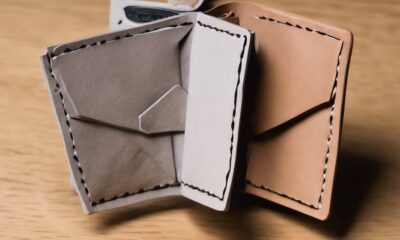
 Vetted4 months ago
Vetted4 months ago14 Best Personalized Father's Day Gifts for Your Husband – Show Him You Care
-

 Alfresco4 months ago
Alfresco4 months agoAlfresco Stacker Doors: Seamless Indoor-Outdoor Living!
-

 Vetted5 months ago
Vetted5 months ago15 Best EMS Foot Massagers for Neuropathy to Soothe Your Feet
-

 Craft and Textiles6 months ago
Craft and Textiles6 months ago15 Best Places to Buy Appliances for Your Home – Top Retailers Reviewed
-

 Craft and Textiles6 months ago
Craft and Textiles6 months ago15 Best Gifts for 4-Year-Old Girls That Will Spark Joy and Creativity
-
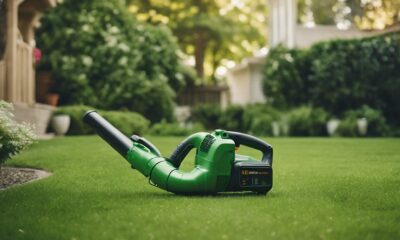
 Craft and Textiles6 months ago
Craft and Textiles6 months ago15 Best Battery-Powered Leaf Blowers for Effortless Yard Work
-

 Craft and Textiles6 months ago
Craft and Textiles6 months ago15 Best Cordless Mowers for Effortless Lawn Care – Top Picks of 2024
-

 Decorative Throws6 months ago
Decorative Throws6 months agoIs It Better to Dry Clean Blankets?








